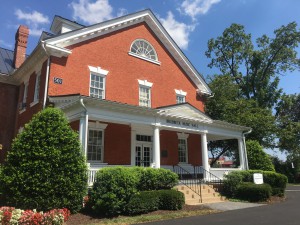
The start of the 2016-2017 academic year has marked a major shake-up for musical theatre at Hood, since the two theatre groups here on campus have merged into one.
The two different groups, Hood College Student Musical Theatre and the Hood College Theater Alliance, put on two separate shows last spring, You’re a Good Man Charlie Brown and Legally Blonde, which both were performed in Brodbeck Music Hall.
“There’s really only one place where a full musical can be performed in, and that’s Brodbeck,” says Gabe Cassutto, class of 2017, previously elected to be the president of Hood College Student Musical Theatre prior to the merger. “Brodbeck is very old, so there was some unnecessary and significant wear on Brodbeck last year because of the two shows.”
According to Cassutto, it was the strain of allocated resources, “both financial and participatory,” that led to the merger.
“The merge ultimately happened because of the financial situation in Student Life, and that there’s just really no way that you can fund two full-length musicals for two different groups and everything that goes into it,” says Carla Kronsbein, class of 2017, and vice president of Hood College Theatre Alliance.
“When we think about a campus the size of Hood, and the resources that we have available, it only makes sense for there to be one predominant organization on campus,” says Dr. Gurzick, former advisor of the Hood College Theatre Alliance and now a co-adviser for Hood College Student Musical Theatre. “So we came up with the decision to merge the groups and as co-advisers, both myself and Professor Staininger, agreed that that was a great way for it.”
The Hood College Theatre Alliance was active for the 2015-2016 academic year, and was the result of complications within the group after the planned production, Urinetown, could not be performed.
“For the 2014-2015 academic year, Hood College Student Musical Theatre planned to put on Urinetown. This show ended up not actually happening, and this issue stemmed from not having enough members in the cast,” says Cassutto. “This was a legal matter. Legally, we had to have a certain number of people in the ensemble and in the main cast. If we didn’t we legally couldn’t put it on, because we would have to change the music.”
Cassutto says that possibly changing the music would have been in violation of a contract that was signed to get the rights to put on the show in the first place. Lynn Staininger, the show’s music director, decided to refuse to continue to work on the show because of the legal obligations that were not being met.

“There is debate, and I will not comment on who is to be at fault for not fulfilling the cast number,” says Cassutto. “Typically, that responsibility will fall amongst the administration, as in the director, the assistant director, the casting director. As a result [of the show’s cancellation], the director and the assistant director decided to create their own group, feeling that they were not able to create a show under the current exec board and cooperating with the music director.”
Kronsbein says this became very complicated.
“Deadlines just were not met, things were falling apart, and in my opinion, rightfully so, the board decided to pull the show,” says Kronsbein. “So then [the director] decided, ‘screw you guys, we’re gonna make our own club where we can do what we want’ So that’s how that happened.”
Kronsbein says that she feels that the divide was about politics, and that once these politics were taken away, the groups were able to come together again.
“I think [the merger] is a great idea. I think that people are finally getting over themselves,” she said. “I’m glad we’re back together, and now we’re under the direction of Lynn [Staininger] and Dr. Gurzick.”
Going forward, the merged groups, which now work under the name Hood College Student Musical Theatre, are going to try working together to put on a spring musical. At this time, both Kronsbein and Dr. Gurzick say that the selected spring show is The Wedding Singer.
Kronsbein hopes other music-related events can be put on throughout the year.
“I see us up and out, and coming back to the traditions and being able to have events, like the Gender Bender Cabaret [and flash mobs], just so that we have things throughout the year and not just one big performance at the end,” Kronsbein said.
Kronsbein also says hopes the Frederick community will be able to be involved in any future Hood productions, since the theatre program at Hood is so small.
At the moment, the groups are putting together their exec boards and planning for the rest of the year.
“We had a meeting and the two groups came together and I thought it was a really valuable meeting,” says Dr. Gurzick. “I think we saw that there are tremendous amounts of interest and enthusiasm.”
It looks like time and compromise are what it will take for these groups to work effectively as one.
“I think that there’s going to have to be a lot of compromise, and I think that if we stick to it for the love of theatre, that it will come out on top,” says Kronsbein. “We’re trying to come to the community as like, this merge happened and we have our [stuff] together, and that we’re not just like blindly wondering what we do know.”
Cassutto is not so sure. “I think having one theater group on campus is a good idea, and I think the merger is great in theory, but unless proven wrong in the following weeks, has seemed to be poor in execution,” he says.
Cassutto says that the next big step is putting together a good administration.
“I want musical theatre at Hood to stick around. I want it to be a thing that people want to go out and do,” Cassutto says. “The founders of this organization are very close friends of mine, and I can’t look them in the eyes and tell them that their legacy at Hood failed while I was here.”



Be the first to comment